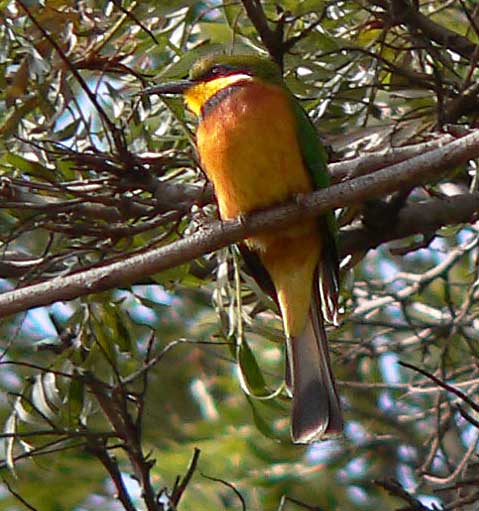
Merops oreobates , Photo: Christiaan Kooyman
Superregnum: Eukaryota
Regnum: Animalia
Subregnum: Eumetazoa
Cladus: Bilateria
Cladus: Nephrozoa
Superphylum: Deuterostomia
Phylum: Chordata
Cladus: Craniata
Subphylum: Vertebrata
Infraphylum: Gnathostomata
Superclassis: Tetrapoda
Cladus: Reptiliomorpha
Cladus: Amniota
Classis: Reptilia
Cladus: Eureptilia
Cladus: Romeriida
Subclassis: Diapsida
Cladus: Sauria
Infraclassis: Archosauromorpha
Cladus: Crurotarsi
Divisio: Archosauria
Subsectio: Ornithodira
Subtaxon: Dinosauromorpha
Cladus: Dinosauria
Ordo: Saurischia
Cladus: Eusaurischia
Cladus: Theropoda
Cladus: Neotheropoda
Infraclassis: Aves
Cladus: Euavialae
Cladus: Avebrevicauda
Cladus: Pygostylia
Cladus: Ornithothoraces
Cladus: Euornithes
Cladus: Ornithuromorpha
Cladus: Ornithurae
Cladus: Carinatae
Parvclassis: Neornithes
Cohors: Neognathae
Ordo: Coraciiformes
Familia: Meropidae
Genus: Merops
Species: Merops oreobates
Name
Merops oreobates (Sharpe, 1892)
Synonyms
Melittophagus oreobates (protonym)
References
Ibis ser.6, 4: 320.
Vernacular names
العربية: وروار قرفي الصدر
català: Abellerol muntanyenc
čeština: Vlha skořicovoprsá
Cymraeg: Gwenynysor bronwinau'r De
dansk: Okkerbrystet Biæder
Deutsch: Bergspint
English: Cinnamon-chested Bee-eater
español: Abejaruco montano
français: Guêpier montagnard
magyar: Hegyi gyurgyalag
italiano: Gruccione pettocannella
日本語: チャムネハチクイ
Nederlands: Bergbijeneter
norsk: Bergbieter
русский: Черногрудая щурка
svenska: Bergbiätare
українська: Бджолоїдка суданська
The cinnamon-chested bee-eater (Merops oreobates) is a species of bird in the family Meropidae. They are found in Burundi, Democratic Republic of the Congo, Ethiopia, Kenya, Rwanda, South Sudan, Tanzania, and Uganda.[1]
Description
The sexes are alike in the cinnamon-chested bee-eater. They have bright green heads, upper parts, and tails; their chins and throats are yellow and outlined in black, with a white extension to the side; their breasts are cinnamon-brown, darkening towards the belly. When perched, their stance is upright with the tail pointing downward. The tail is blackish with an orange base and white tip when seen from the front, while from the back it is mainly green, with black edges visible when it is flared. This bird can be distinguished from the somewhat similar little bee-eater by their larger size, darker colouring, white cheek patches, and the upland habitat where they are found.[2]
Ecology
This bird lives in upland regions, usually between 1,800 and 2,300 metres (5,900 and 7,500 ft) and can be found associated with wooded hillsides and forest edges, clearings, plantations, and gardens. Their diet consists mainly of honeybees although they also eat moths, butterflies, dragonflies, beetles, and other flying insects. They seem to be an adaptable species and able to withstand loss of their forest habitat.[2] They measure 22 centimetres (8.7 in) in length and weigh 17–38 grams (0.60–1.34 oz).[3]
Status
The cinnamon-chested bee-eater has a very wide range and although the population size has not been quantified, they are thought to be large, and the International Union for Conservation of Nature has assessed their conservation status as being of "least concern".[1]
References
BirdLife International (2016). "Merops oreobates". IUCN Red List of Threatened Species. 2016: e.T22683697A92996442. doi:10.2305/IUCN.UK.2016-3.RLTS.T22683697A92996442.en. Retrieved 12 November 2021.
Fry, C. Hilary; Fry, Kathie (2010). Kingfishers, Bee-eaters and Rollers. Bloomsbury Publishing. p. 257. ISBN 978-1-4081-3525-9.
CRC Handbook of Avian Body Masses by John B. Dunning Jr. (Editor). CRC Press (1992), ISBN 978-0-8493-4258-5.
Retrieved from "http://en.wikipedia.org/"
All text is available under the terms of the GNU Free Documentation License

